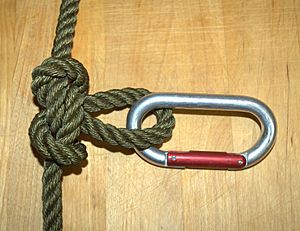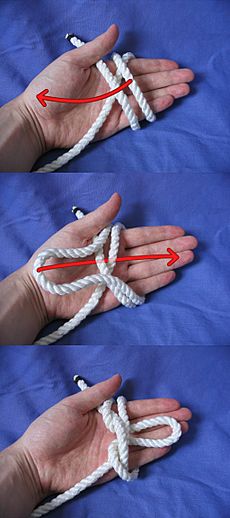Butterfly loop facts for kids
Quick facts for kids Butterfly loop |
|
|---|---|

A butterfly loop with a carabiner.
|
|
| Names | Butterfly loop, alpine butterfly knot, butterfly knot, lineman's loop, Swiss loop, lineman's rider |
| Category | Loop |
| Related | Alpine butterfly bend, farmer's loop, artillery loop, span loop |
| Releasing | Non-jamming |
| Typical use | Fixed loop on the bight. Isolating a worn section of rope. |
| ABoK | #331, #532, #1053 |
| Instructions | [1] |
The butterfly loop is a very useful knot that creates a strong, fixed loop in the middle of a rope. It's also known as the lineman's loop, butterfly knot, alpine butterfly knot, Swiss loop, and lineman's rider. You can tie this knot even if you can't reach the ends of the rope. This is a big help when you are working with long climbing ropes.
The butterfly loop is excellent for setting up ropes because it can handle being pulled in many directions. It also has a balanced shape, which makes it easy to check if it's tied correctly. Climbers use it for traverse lines, some anchors, making rope slings shorter, and to isolate damaged parts of a rope.
Contents
History of the Butterfly Loop
The first time this knot was shown was in 1914. It was in a book called Rope and Its Uses by A.A. Burger. This book was part of a guide from what is now Iowa State University. Burger called it the lineman's rider. He said that linemen, especially telephone workers, often used it. He also wrote about how strong the knot was and how it could hold tension from any direction.
The knot became linked with mountaineering and its "butterfly" name in 1928. This happened after an article in the Alpine Journal by C.E.I. Wright and J.E. Magowan. They said they came up with the butterfly noose themselves. They were trying to find better knots for climbers. They named it "butterfly" because they thought it looked a bit like a butterfly. Later, they changed the name to butterfly loop or just butterfly. This was because the knot doesn't tighten like a noose. They thought their knot was new, but they also said it was hard to be sure if it had never been used before.
When Clifford Ashley wrote about the knot in 1944, he called it the lineman's loop. He said J.M. Drew first published it. Drew had an article called "Some Knots and Splices" from 1912. However, a later version of Drew's article from 1913 does not mention the butterfly loop.
How to Use the Butterfly Loop
You can attach the loop to a climbing harness. This is usually done with two carabiners. Make sure their gates face opposite directions for safety.
The knot can also help if a rope has a damaged section. You can tie the knot so the damaged part is inside the loop. In this case, you would not use a carabiner on that loop. The loop part is not under stress when the other two parts of the rope are pulled.
Sometimes, people tie a similar-looking knot by mistake. This is called a "false butterfly." It can slip and is not as safe. Wright and Magowan called this less secure knot the "half-hitch noose." It's important to tie the butterfly loop correctly.
Advantages of the Butterfly Loop
- It forms a strong and secure loop once it's set.
- The knot can be pulled in three ways: from each end of the main rope and from the loop itself.
- It's fairly easy to untie, even after it has been pulled tight. It might be harder if it gets wet.
- You can adjust the size of the loop more easily than with other knots.
- It's simple to check if the knot is tied correctly.
- You can tie it easily even when wearing gloves.
- It can even be tied with just one hand.
Disadvantages of the Butterfly Loop
- It can be hard to tie around a solid ring or similar object.
- Tying it incorrectly can result in the less secure "false butterfly" knot.
- It works best with ropes that are not too stiff.
Variations of the Butterfly Loop
The double butterfly loop is a version with two loops. Both loops are strong and do not collapse. This gives you two places to clip into, and they have the same good and bad points as a single-loop butterfly.
See also
 In Spanish: Nudo mariposa alpino para niños
In Spanish: Nudo mariposa alpino para niños



